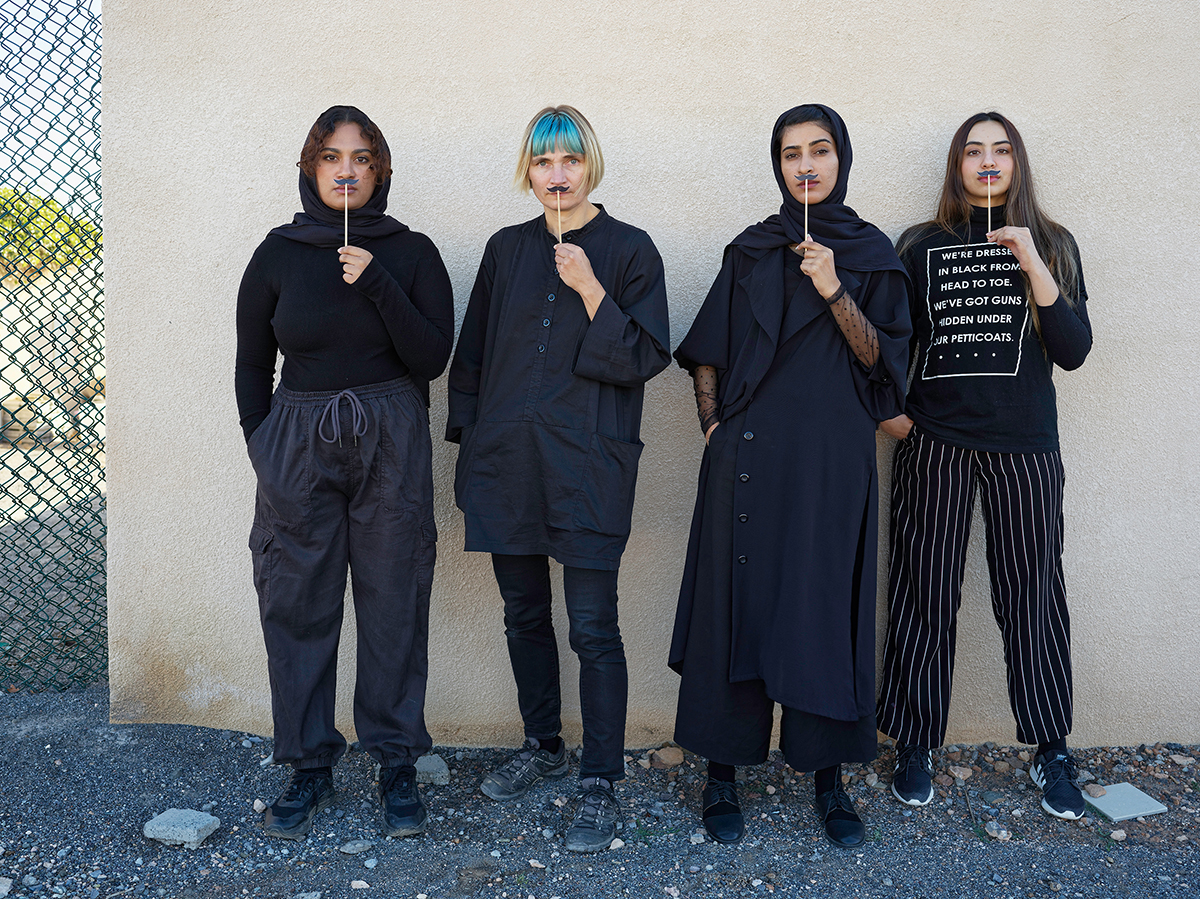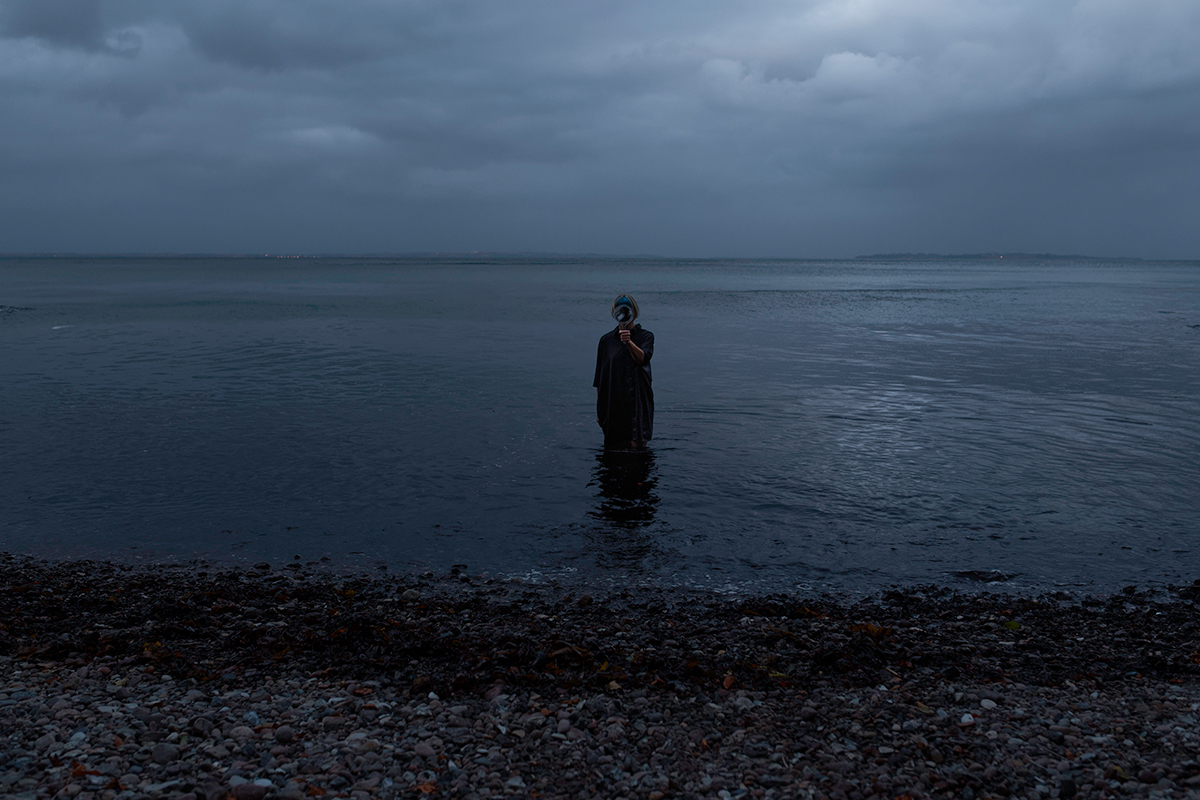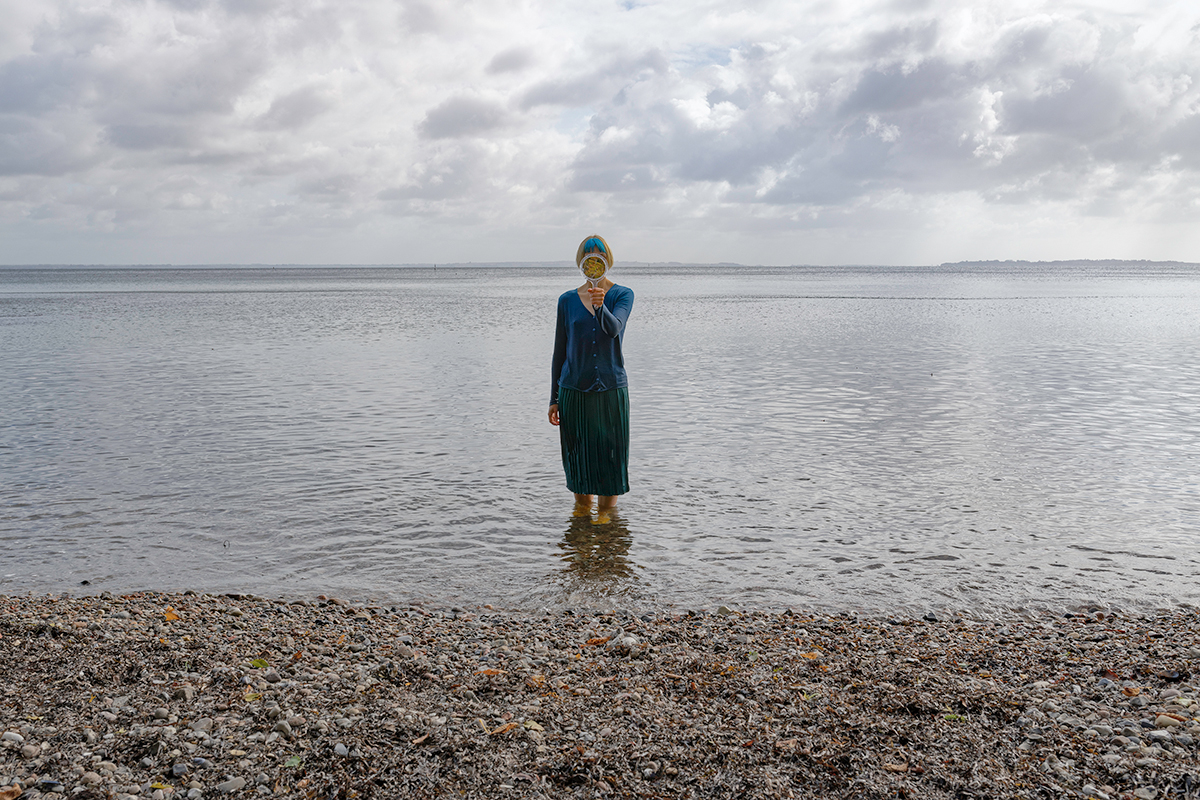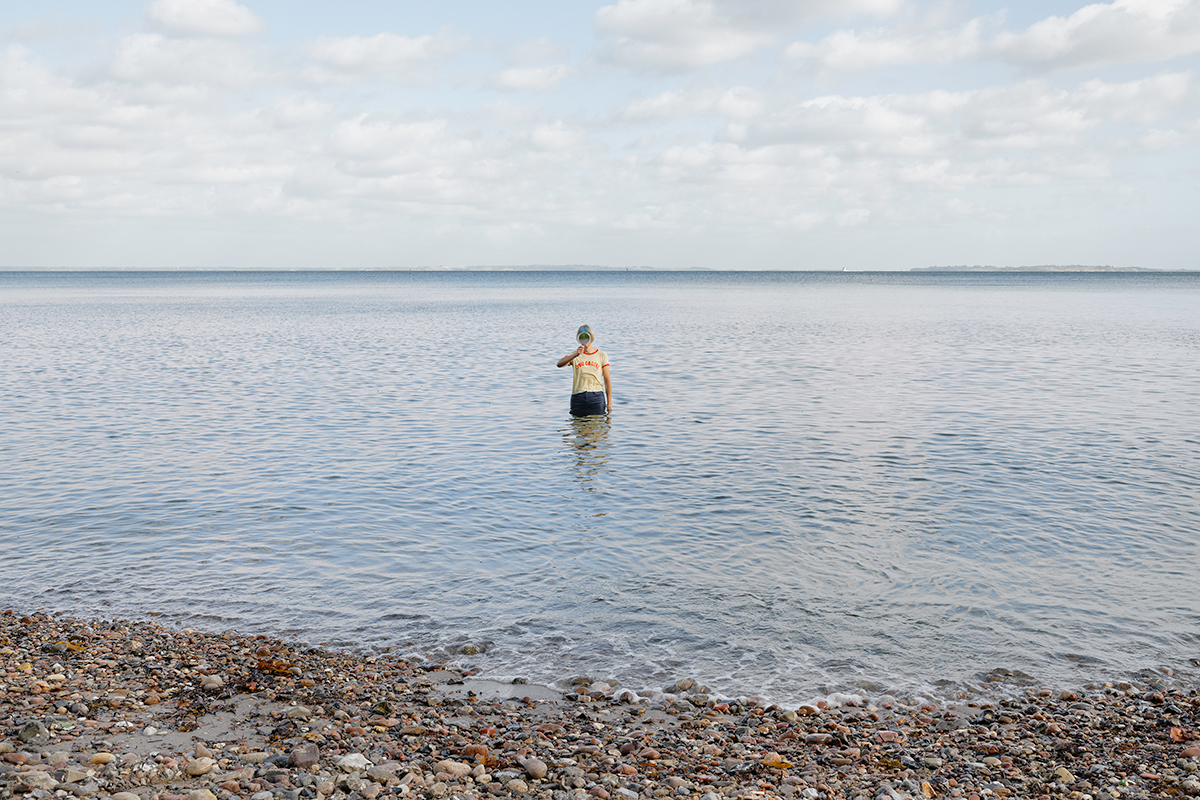Elina Brotherus (b. Helsinki, Finland) works in photography and moving image. Her work has been alternating between autobiographical and art-historical approaches. Photographs dealing with the human figure and the landscape, the artist’s relation, and the model gave way to images on subjective experiences in her recent work Annunciation and Carpe Fucking Diem. In her current work, she revisits Fluxus event scores and other written instructions for performance-oriented art of the 1950s-70s. Another ongoing interest is photographing in private houses by architects like Alvar Aalto, Friedensreich Hundertwasser, or Michel Polak, where Brotherus takes various imagined characters and brings a tranquil human presence to these iconic spaces.



The Avant-Garde Doesn’t Give Up
Emerald Arguelles: How did you start becoming interested in photography?
Elina Brotherus: My father was a hobby photographer. I remember him printing black and white photographs in the bathroom when I was small. He died when I was 9, and at 15, I found his Olympus camera. That was the start. It became serious much later – when after four years of Chemistry studies I realized I had made a wrong choice. That’s when I applied for and got into an art school. Best move I’ve done in my whole life!
EA: Can you talk about the feminist credo: the personal is (also) the political and what that means to you?
EB: I started to actively think about gender issues in 2018 when Marie Docher published the number of solo shows at the Arles Photography Festival: 80% of men, 20% of women. I found out the figures have been pretty much the same throughout the history of the festival, other festivals, mid-career museum shows, gallery representations, etc. The Arles statistics were an eye-opener. I thought: This is not ok. Marie started a collective called La part des femmes (Women’s’ Share); she wrote a petition against the festival direction, which I signed among many women – and men – and things did change for the next year. I have been actively following the debate ever since. When I said to Anna Tellgren, the director of the Photography Department at Moderna Museet in Stockholm, how lucky we are in Scandinavia that we don’t have to think of these issues every day, she said. On the contrary, it’s because we think of them every day that we are in a better situation. I also learned that several curator friends work actively against the bias: whenever they are invited to nominate an artist, they nominate a woman – because, statistically, the men in the group are more likely to nominate a man. Always when I get to be in a power position like in a jury for selecting exhibitors to an art space or in a grant committee, I practice feminist counting: before the final round of decisions, we check how many women, how many men we have, and take care to have 50/50 in the final selection. We need to pay attention. This is the only way to fairness. I grew up in a country that boasts about its gender equality. We have had both a female president and a female prime minister (right now for a second time). So it’s like, yeah, we can tick, the box and we’re good. Yet, all the time we hear of qualified women being bypassed in filling hi-rank jobs by some less qualified man. If the woman makes a case about it, she is regarded as difficult and selfish. If we look globally, the world is very far from parity and equal opportunities for all people. I’m for anonymous candidacies in all sectors of life. It has been proven for instance that when orchestras hire new musicians, they hire a bigger proportion of women when the candidates play behind a curtain. The same should be done for all kinds of applications: from jobs to art prizes, grants, residencies… The jury should get the applications without names or genders. I should mention that gender is not the only issue: age is as well. And especially for women. I have taken my year of birth away from my resume. Do you think I’m a worse artist now than when I was a recent graduate? It’s ridiculous. So many opportunities are tailored to young artists only. Last year, I made a piece with a group of colleagues from Oman where we all hold a fake mustache on a stick under our noses. It’s called ‘The Avant-Garde Doesn’t Give Up.’ you I want it to be an empowering piece for women who struggle in doing what they want, who struggle being artists in difficult conditions. I want to tell: You are the avant-garde. You give an example; you are the role models, others will follow, and it will be easier for them. Another recent piece is called.
‘Artist as Clown’ (2020). It’s a nude with a serious expression but with a clown’s smiley mouth drawn around her own mouth with lipstick. So, I state, with tong in cheek but half-serious: A woman, to survive in the art world, needs to be a man, needs to be a clown, or needs to be naked.


EA: What or who are your influences?
EB: In a new book (Elina Brotherus: Why not?, Hirmer Verlag and Weserburg Museum of Modern Art, Bremen 2020) museum director Janneke de Vries and curator Ingo Clauss talk about my three important sources: art history, literature and architecture. Art history was already visible in an early series ‘The New Painting’ (2000-2004). Then I got interested in the artist and the model and their intertwined relationship (especially in somebody doing self-portraits). Lately I’m drawing inspiration from the recent art history of Fluxus, Feminist avant-garde and the like. My interest in literature manifests itself in a body of work from last year called ‘Sebaldiana. Memento mori’ where I took W.G.Sebald’s posthumously published fragmentary texts on Corsica as my guide when working on the island by the Centre’s invitation méditerranéenne de la photographie. The third big chapter in my practice is architecture. I have been photographing in several iconic houses by architects like Alvar Aalto, Michel Polak or Friendensreich Hundertwasser. I’m continuing the series each time I get access to another iconic house. I do different kinds of architectural photography because I introduce a human being into the pictures. I play different imaginary characters who could have lived in the houses back in time or were perhaps friends or relatives on a visit. The characters let the spectator enter the house with them and inspire possible storylines.




EA: Can you talk about the process and concept of the “Louisiana Mirror Piece”?
EB: Last year, I enjoyed becoming a part of my favorite museum collection, the Louisiana Museum of Modern Art in Humlebaek, Denmark. Two of my pieces were put up in the collection exhibition and I was invited to a small dinner party at the boathouse. They told me: “You are now a part of the Louisiana family. If you ever want to come over, we have a guest room here in the boathouse, where you can stay.” You know, if you give me an opportunity like that I will not say no, so quickly I imagined a project I could do to stay in the lovely guest room by the sea. The first Fluxus inspired piece I ever did was after an event score of the Japanese artist Mieko Shiomi. I have done several pieces after her scores later on. But the first one was her ‘Mirror Piece’ from 1963. I saw the little card with the text at the MoMA in 2012 without knowing what it was. I did a video piece two years later where I used the score. The instruction goes: “Stand on the sandy beach with your back to the sea. Hold a mirror before your face and look in it. Then step back to the sea and enter into the water.” I have always wanted to redo this piece in different places, so the Louisiana invitation was a perfect opportunity. I did the piece on the beach behind the museum five times: early evening, at night, at sunrise, early afternoon, late afternoon. Each time the light is different and I wear different colors. The Mieko score doesn’t say what you have to do once you are in the water. My solution is to walk as far as I can, then return, and while walking back to the shore, I also turn the mirror around so that it now shows to the camera reflections of sky, water and trees. The videos are short: from 1’42” to 2’40”. Ideally they are all shown on separate screens so you can compare them at one glance.

EA: With most of your images, the subjects’ faces are not the focal point; where was that concept born?
EB: One reason is that when you show the face, you fix the identity. It’s like a signature – this is me, or this is so-and-so. When you see the person from the back, it can be whoever – it can be you. The spectator can identify themselves with the person or feel invited to join in. John Baldessari said this in the introduction to his Portrait Series (1974), which I have been using as a trigger to some of my new work: “I have always avoided doing portraits as something per se. A face is so powerful and dominates all else. In this series, I have hidden the face in various manners, trying to allow other information to surface and define the person (…) If art is a mystery. The face is a betrayer and should be hidden.” Baldessari used the famous dots he put on people’s faces. I use all kinds of different ways to hide the face.
EA: What do you want the reader/viewer to know?
EB: During this strange year of 2020, I have started to value the art audience more than ever. I have always enjoyed interacting with my public, but now that so many things have been canceled I realize how much I miss the exchange. Seeing art and talking about art together is like gathering around a campfire. I want you to know that I miss you, my fellow human beings who care for art. Please continue going to exhibitions if you can, even though the openings are canceled and the artist perhaps couldn’t travel to the country. Let’s enjoy the local art scene. That’s the best thing we can do now and it brings hope to both the viewer and the viewed, the spectator and the artist.


Elina Brotherus
The Avant-Garde Doesn’t Give Up
October 1 – October 31, 2020
Martin Asbæk Gallery is pleased to present “The Avant-Garde Doesn’t Give Up” by Elina Brotherus. As the Finnish artist’s fourth solo exhibition in the gallery, it consists of works in which Brotherus realizes or interprets a range of written instructions in her photographs or video works. These instructions may be actual scripts for performances or Fluxus works, or simply a phrase from a book, a title of a work of art, or some other kind of verbal statement that can be used as a script for an artistic act or pose.
Most of Elina Brotherus appropriate’ works are relatively simple and contain an ironic element right from the outset. For example, the Danish composer and Fluxus artist Henning Christiansen’s idea of painting one of his ears green (as well as those of all customers at a selected hair salon) to ‘listen to nature’ is a teasingly banal way of depicting a green awareness of nature and the environment, but also a strong call for us all to direct our attention along new channels, listening to the world as music. When Brotherus repeats this gesture in work Das grüne Ohr 2 (2017), this is simultaneously an homage to the work and a shift in its meaning.
Earlier in her career, Brotherus worked partly autobiographically, partly based on painterly tradition and art history – in both cases using herself as a model – but in 2016, she began using instructions for Fluxus works as a starting point for her art. With this move, her works took a more performative turn, and the exhibition sees her further developing this movement in various ways in recent works that all take a textual starting point.
Simultaneously critiquing and admiring past eras, Brotherus operates by the feminist credo ‘the personal is (also) the political.’ Her work thus stands as a continuation as well as a modulation of previous avant-garde movements. This is evident in the work that lends the exhibition its title; The, Avant-Garde Doesn’t Give Up from 2019. The work references an Asger Jorn disfiguration from 1962 bearing the same title, in which he painted a mustache on an existing painting of a little girl. Itself refers to a classic 1919 work by Marcel Duchamp who equipped a postcard of Mona Lisa with facial hair. Brotherus’ work embodies the avant-garde as stubborn and pubescent, regarding it with a certain ambivalence. Acknowledging these movements’ importance, she takes the avant-garde into a new era, with new gender roles. Accompanying the artist in work are three young female artists from Oman she met during a residency, all dressed in black and looking directly into the camera. Tongue in cheek, but deadly the serious, they are demonstrably not assuming traditional gender roles, not seeking to be the male gaze’s objects of desire, but rather asserting themselves as powerful artists with unambiguous agency.
The picture is a powerful example of how, by combining strong visual images, underlying texts, and subtle performative elements, Brotherus brings forth an idiosyncratic art history in which the absurd, the ambiguous and personal interpretations propel the viewer on a journey through various reflections on the nature and essence of art.
Elina Brotherus was born in 1972, Helsinki, Finland. Lives and works between Paris and Helsinki. She has exhibited all over the world, with notable solo exhibitions at Centre Pompidou, Paris; The National Art Center, Tokyo; Museum Hundertwasser, Vienna; Weserburg Museum für Moderne Kunst, Bremen (opening 25/10). Represented in numerous prominent collections, such as Saatchi Collection, London; Louisiana Museum of Modern Art, Humlebæk; Museo Nazionale Delle Arti del XXI secolo (MAXXI), Rome; Moderna Museet, Stockholm.
To view more of Elina Brotherus’s work, please visit their website.